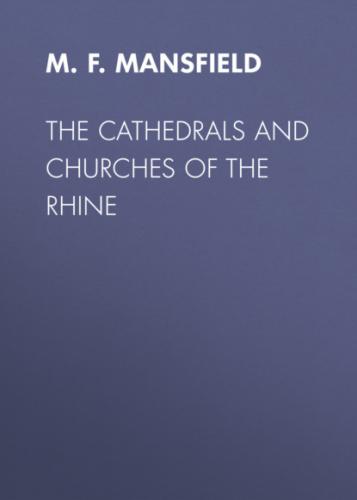Perhaps it is for this reason alone that the great Gothic cathedral at Cologne was completed at a late day with no base Renaissance interpolation in its fabric.
V
THE ACCESSORIES OF GERMAN CHURCHES
Up to the tenth century the German basilicas were but copies of the Roman variety. Even the great cathedral at Trèves, with its ground-plan a great square of forty metres in extent, was but a gross imitation of the Romanesque form of the sixth century.
Later, in the eighth century, came the modified Byzantine form which one sees at Aix-la-Chapelle.
With the eleventh century appeared the double-apsed basilicas, but, from this time on, German ecclesiastical art divorced itself from Latin traditions, and from the simple parallelogram-like basilica developed the choir and transepts which were to remain for ever.
The crypt is a distinct and prominent feature of many German churches. On the Rhine curious and most interesting examples are very frequent, those at Bonn, Essen, München-Gladbach, Speyer, Cologne (St. Gérêon's), Boppart, and Neuss being the chief. All of these are so constructed that the level of the pavement is broken between the nave and choir, producing a singularly impressive interior effect.
Speyer has the longest, and perhaps the largest, crypt in all Germany.
Where the edifice has remained an adherent of Catholicism, the crypt often performs the function of a place of worship independent of the main church, it being fitted up with one or more altars and frequently other accessories.
As the crypt, instead of being only an occasional attribute, became general, squared, or even more rude, capitals replaced the antique and classical forms which Christian Italy herself had adopted from pagan Greece.
These squared or cubic capitals are particularly noticeable at Neuss, at München-Gladbach, in St. James at Cologne, and in the old abbey of Laach.
Towers came to be added to the west fronts, but the naves often remained roofed with visible woodwork, though, by the end of the century, the stone-vaulted nave had appeared in the Rhine district, and the pillars of pagan birth had given way to the columns and colonnettes of Latin growth.
What is known as the German manner of church-building had more than one distinguishing feature, though none more prominent than that of the columns of the nave and aisles. The naves were in general twice the width of their aisles, and the bays of the nave were made twice the width of those of the aisles. Hence it followed that every pier or column carried a shaft to the groin of the aisle vault, and every alternate one a shaft to the nave vault; and so grew the most distinct of all German features of Romanesque church-building, alternate light and heavy piers in the nave.
It is on the Rhine, too, that one comes upon occasional examples of rococo architectural decoration, a species which sounds as though it might originally have been Italian, but which was originally French. At its best it is seldom seen on the exterior, but on inside walls and porticoes, notably at Bruchsal on the Rhine, one sees a frankly theatrical arrangement of ornate details.
By the twelfth century the particular variety of Romanesque architecture which had developed, and still endures, in the Rhine valley had arrived at its maturity.
The thirteenth century saw the interpolation and admixture of Gothic, which elsewhere, in France in particular, was making such great strides.
Towers multiplied and became lighter and more graceful, and great Gothic arched windows gave place to round-headed ones, though scarcely ever to the entire exclusion of the latter variety.
The species of cross-bred style which forms the link between the Romanesque and Gothic abounds along the Rhine, and examples are frequently encountered.
The semicircular apsides, with a decorative band beneath the cornices of the exterior galleries, are also a distinctly Rhenish detail. They are to be seen in St. Peter's at Bacharach, at St. Castor's at Coblenz, St. Martin's at Cologne, the cathedral at Bonn, in St. Quirinus at Neuss, and again at Limburg.
The Rhenish bell-towers are a variety distinct from the towers and spires usually met with, and often terminate suddenly, as if they were unfinished.
Finally, there are a number of churches in this region which offer the singular, though not unique, disposition of a chevet showing a triple apsis. Notable examples of this style are St. Maria in Capitola, St. Andrew and St. Martin at Cologne, and St. Quirinus at Neuss.
The churches of the Rhine valley are abundantly supplied with steeples, often in groups far in excess of symmetry or sense, as for instance the outré group at Mayence, which is really quite indescribable.
Конец ознакомительного фрагмента.
Текст предоставлен ООО «ЛитРес».
Прочитайте эту книгу целиком, купив полную легальную версию на ЛитРес.
Безопасно оплатить книгу можно банковской картой Visa, MasterCard, Maestro, со счета мобильного телефона, с платежного терминала, в салоне МТС или Связной, через PayPal, WebMoney, Яндекс.Деньги, QIWI Кошелек, бонусными картами или другим удобным Вам способом.
